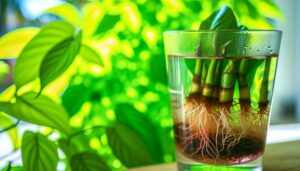How to Propagate Monstera Obliqua? A Complete Guide!
To propagate Monstera Obliqua, start in spring or early summer for ideal growth. Use sterilized pruning shears to cut a mature stem with at least two nodes.
Let the cut end callous over for a few hours. Apply rooting hormone to encourage development.
Place the cutting in well-draining soil and position it in bright, indirect light. Maintain humidity at 60-80% and the temperature within 65-80°F.
Keep the soil consistently moist but not waterlogged. Once roots form, transplant to new pots, ensuring minimal root disturbance.
For more detailed steps, explore various aspects of this process.
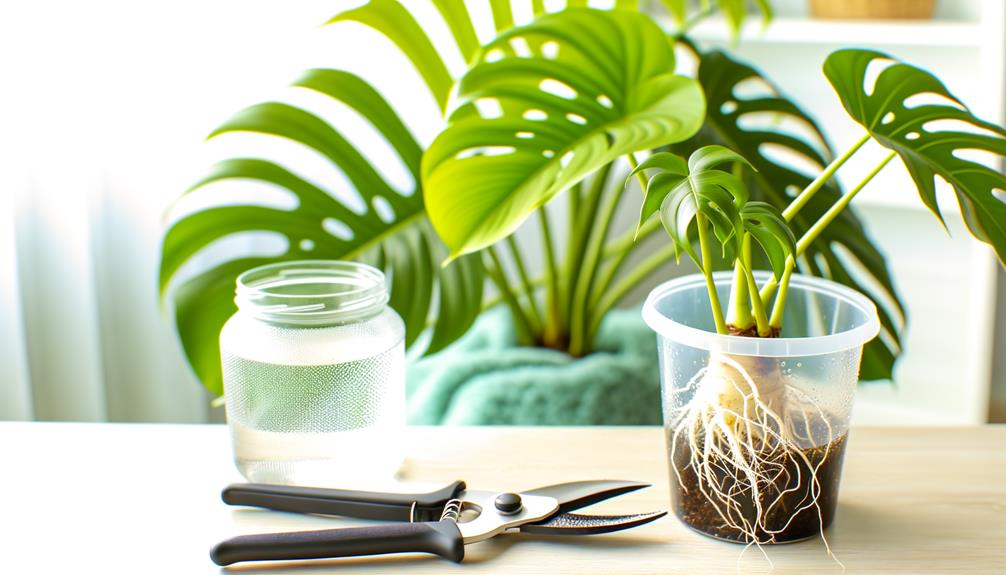
Key Takeaways
- Use sharp, sterilized pruning shears to take a cutting just below a healthy node.
- Select a mature stem with at least two nodes and leaves for the cutting.
- Allow the cut end to callous over for a few hours before planting.
- Place the cutting in well-draining soil, keep it moist, and maintain high humidity.
- Ensure the cutting receives bright, indirect light to promote root development.
Understanding Monstera Obliqua
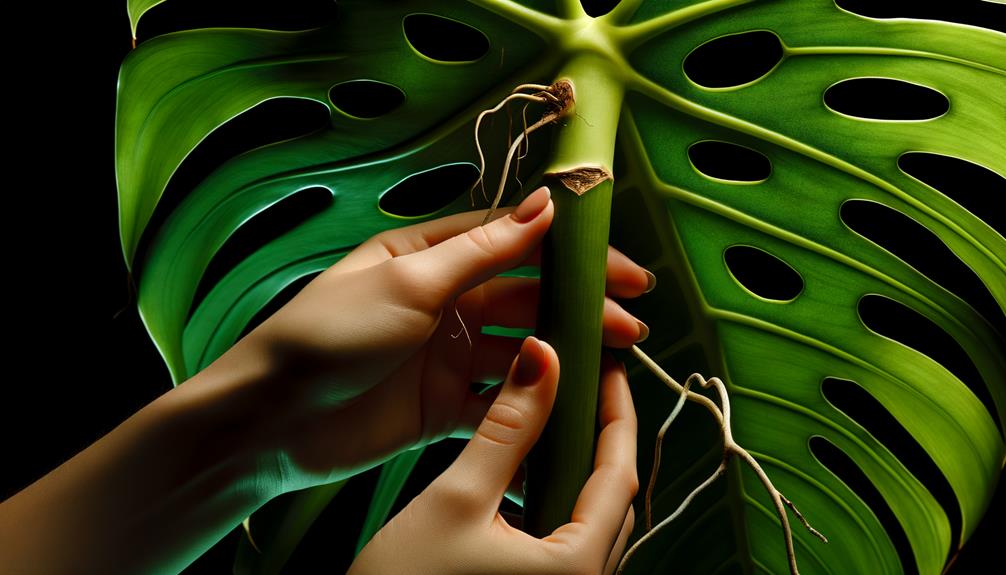
Monstera obliqua, often mistaken for its more common relative Monstera adansonii, is a rare and delicate species with distinctive perforations and fenestrations in its leaves. You’ll recognize it by its paper-thin foliage and extensive holes, which are more pronounced than those in adansonii.
This species thrives in high humidity and indirect light, mimicking its natural rainforest habitat. To ensure optimal growth, maintain a consistent temperature between 65-80°F (18-27°C). Use well-draining soil, rich in organic matter, to prevent root rot.
Regularly mist the leaves to replicate the humid environment it prefers. Understanding these specific needs is essential before attempting propagation, as Monstera obliqua‘s sensitive nature requires precise care and attention.
Best Time for Propagation
Spring and early summer are ideal periods for propagating Monstera obliqua due to the plant’s vigorous growth phase and ample light availability. During these months, you’ll find the plant is more receptive to cutting and rooting, increasing your chances of successful propagation.
To clarify, consider these factors:
- Light Intensity: Enhanced daylight promotes photosynthesis, aiding root development.
- Temperature: Warm temperatures stimulate metabolic processes, facilitating faster growth.
- Humidity: Higher humidity levels support the delicate cuttings, preventing dehydration.
Necessary Tools and Supplies

You’ll need sharp pruning shears to guarantee clean cuts, which help prevent disease.
Apply rooting hormone powder to the cut ends to promote faster root development.
Use clean containers filled with the appropriate growing medium to provide a sterile environment for the cuttings.
Sharp Pruning Shears
A pair of sharp pruning shears is vital for making clean cuts when propagating Monstera obliqua. Clean cuts minimize harm to the plant and lessen the chance of infection.
To guarantee your pruning shears are efficient, you must:
- Hone regularly: Dull blades can crush stems instead of slicing, harming your plant’s tissue.
- Sterilize before use: Wipe the blades with rubbing alcohol to prevent the spread of disease.
- Inspect for rust: Rust can weaken the blade’s effectiveness and introduce contaminants.
Rooting Hormone Powder
Alongside your sharp pruning shears, you’ll need rooting hormone powder to encourage the development of strong, healthy roots in your Monstera obliqua cuttings.
Begin by purchasing a high-quality rooting hormone powder from a trusted garden supply store. Before applying, make sure the cut end of each cutting is slightly moistened to help the powder adhere.
Dip the cut end into the rooting hormone powder, coating it evenly without oversaturating. Gently tap off any excess powder. This step is essential as it stimulates root growth by supplying essential hormones directly to the cutting.
Once coated, you’re ready to proceed with planting the cuttings in your prepared growing medium. Proper use of rooting hormone powder significantly enhances your chances of successful propagation.
Clean Containers
Why is it important to use sanitary vessels when propagating Monstera obliqua?
Sanitary vessels prevent contamination, ensuring a healthy environment for root development. Unclean vessels harbor bacteria and fungi, which can infect the cuttings and hinder growth.
To achieve best possible results, make sure your vessels are:
- Sanitized: Submerge them in a bleach solution (1 part bleach to 9 parts water) for 10 minutes.
- Thoroughly Rinsed: Remove any residue by rinsing with clean water after sanitization.
- Dried Completely: Use a lint-free cloth or air dry to avoid introducing contaminants.
Selecting the Right Cutting
To begin, make sure you identify healthy nodes, as these are important for successful propagation. Look for nodes that are firm and free from any signs of disease or damage.
Additionally, choose mature stems that are at least a few inches long and have several leaves to maximize the chances of thriving new growth.
Identify Healthy Nodes
When selecting a cutting for propagating Monstera obliqua, it’s important to identify healthy nodes. These are the points on the stem where leaves and roots develop. Look for nodes that are plump and firm, as these are more likely to produce robust growth. Avoid nodes that appear shriveled or discolored, as they may not root effectively.
Ensure each cutting has at least one node, although two or more nodes will increase the chances of successful propagation. Check that the stem around the node is free from pests or diseases.
Firmness: Nodes should feel solid and not mushy.
Color: Healthy nodes are typically green or light brown.
Leaf Growth: Nodes with new or emerging leaves indicate active growth.
Choose Mature Stems
Selecting the right cutting involves choosing stems that are mature and well-developed, guaranteeing a higher chance of successful propagation. Look for stems that are at least six inches long with multiple nodes and healthy leaves. Avoid young, thin, or weak stems as they’re less likely to root successfully.
Inspect the stem for any signs of disease or pests; healthy stems should be firm and vibrant. Cut the stem just below a node using sterilized pruning shears to prevent infection. Nodes are essential as they contain the necessary cells for root development.
Preparing the Cutting
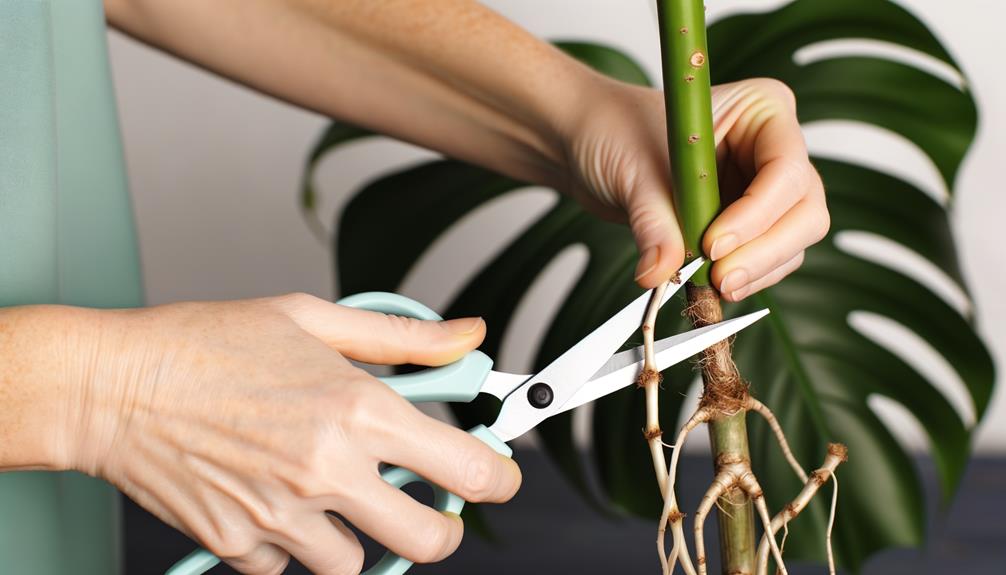
Start by selecting a healthy Monstera obliqua stem with at least two nodes and a few leaves. Make sure your cutting tools are sterilized to prevent infections. Make a neat cut just below a node using a sharp knife or pruning shears. This node is vital as it’s where roots will develop.
Next, trim any leaves near the base to minimize energy expenditure. Your cutting should have:
- Two nodes: Essential for root and shoot development.
- Healthy leaves: Indicate a strong cutting.
- Neat cuts: Prevent disease and promote faster rooting.
After preparing the cutting, you’ll need to allow the cut end to callous over for a few hours. This step reduces the risk of rot and increases the chances of successful propagation.
Rooting in Water
Placing your prepared Monstera obliqua cutting in a clean jar of water initiates the rooting process, making certain the nodes are submerged but the leaves remain above water. Change the water every few days to prevent stagnation and bacterial growth. Position the jar in a spot with bright, indirect light to encourage healthy root development. You should see root growth within 2-4 weeks.
| Step | Description |
|---|---|
| 1. Clean Jar | Use a sanitized jar to avoid contamination. |
| 2. Add Water | Fill with room-temperature water. |
| 3. Submerge Nodes | Ensure nodes are submerged. |
| 4. Change Water | Refresh water every 2-3 days. |
| 5. Light | Place in bright, indirect light. |
Monitor the cutting closely, watching for signs of rot or disease.
Rooting in Soil
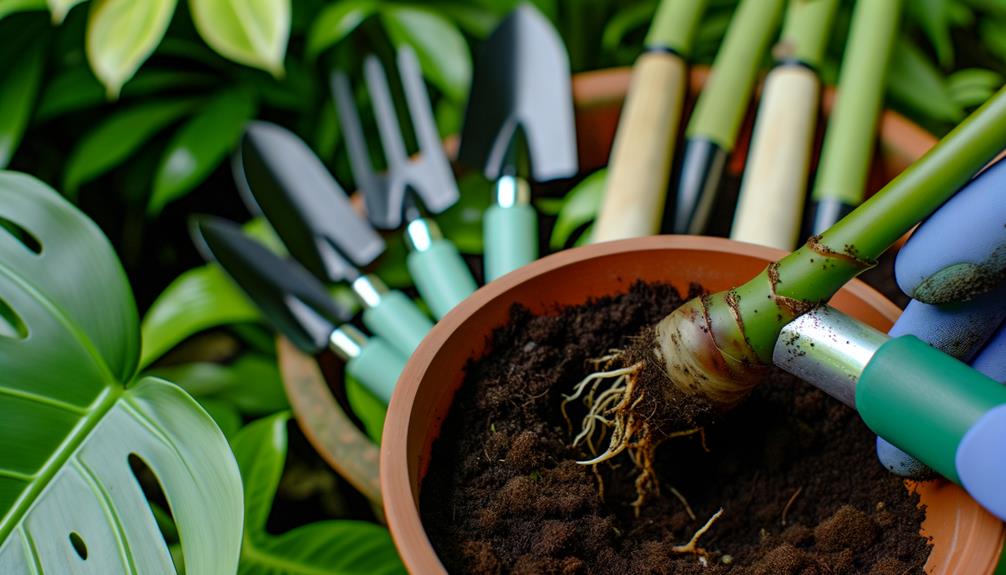
For those preferring to root Monstera obliqua directly in soil, begin by preparing a well-draining potting mix to guarantee proper aeration and moisture control. Select a small pot with drainage holes to prevent waterlogging. Plant the cutting with at least one node below the soil surface, ensuring the aerial roots are covered.
To enhance rooting success, consider the following:
- Moisture Balance: Keep the soil consistently moist but not soggy.
- Depth: Plant cuttings deep enough to stabilize them but shallow enough to avoid rot.
- Sterilization: Use sterilized tools to make clean cuts and reduce infection risk.
Gently firm the soil around the cutting, and water it lightly. Place the pot in a location with indirect light and monitor moisture levels regularly.
Creating the Ideal Environment
To create the perfect setting for your Monstera obliqua, make certain it receives bright, indirect light and maintains a humidity level between 60-80%.
Use a hygrometer to monitor humidity and a humidifier if needed. Place your plant near a window with filtered sunlight, avoiding direct sun which can scorch the leaves.
Keep the temperature between 65-80°F (18-27°C) for prime growth. Ensure proper air circulation by using a small fan, which helps prevent mold and pests.
Opt for a well-draining potting mix to evade waterlogging. Use a container with drainage holes to prevent root rot. Regularly check soil moisture, keeping it consistently moist but not waterlogged.
Adhering to these parameters will nurture a healthy environment for your plant.
Caring for New Cuttings
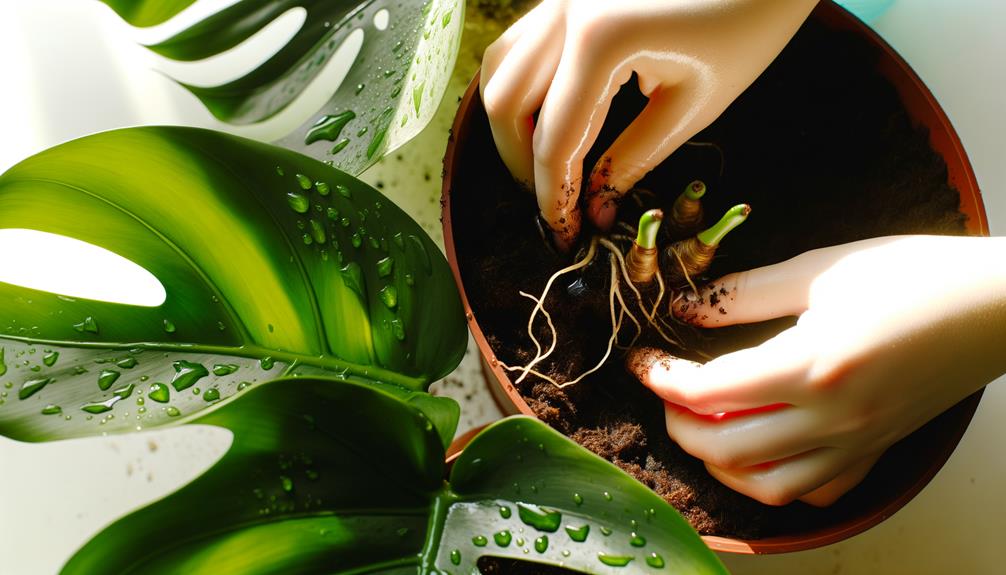
Once you’ve established the ideal environment for your Monstera obliqua, it’s time to focus on nurturing the new cuttings to guarantee successful propagation. Begin by maintaining the cuttings remain consistently moist without being waterlogged. Position them in indirect, bright light to encourage root development. Regularly inspect for signs of rot or fungal issues, and address them promptly.
- Humidity: Sustain a humidity level of 60-80% using a humidity dome or misting.
- Temperature: Keep the temperature between 70-75°F (21-24°C).
- Airflow: Ensure sufficient airflow to prevent mold growth, but avoid direct drafts.
Transplanting Rooted Cuttings
After your Monstera obliqua cuttings have developed a robust root system, carefully prepare to transplant them into individual pots filled with well-draining soil.
Start by selecting pots with drainage holes to prevent waterlogging.
Gently remove the cuttings from their current medium, ensuring to minimize root disturbance.
Place each cutting in its new pot, positioning it so the roots are well-covered, and the stem is upright.
Fill in around the roots with fresh soil, lightly pressing down to eliminate air pockets.
Water thoroughly until water drains from the bottom, then place the pots in a bright, indirect light setting.
Monitor soil moisture and avoid overwatering, ensuring the new plants establish themselves in their new environment.
Troubleshooting Common Issues
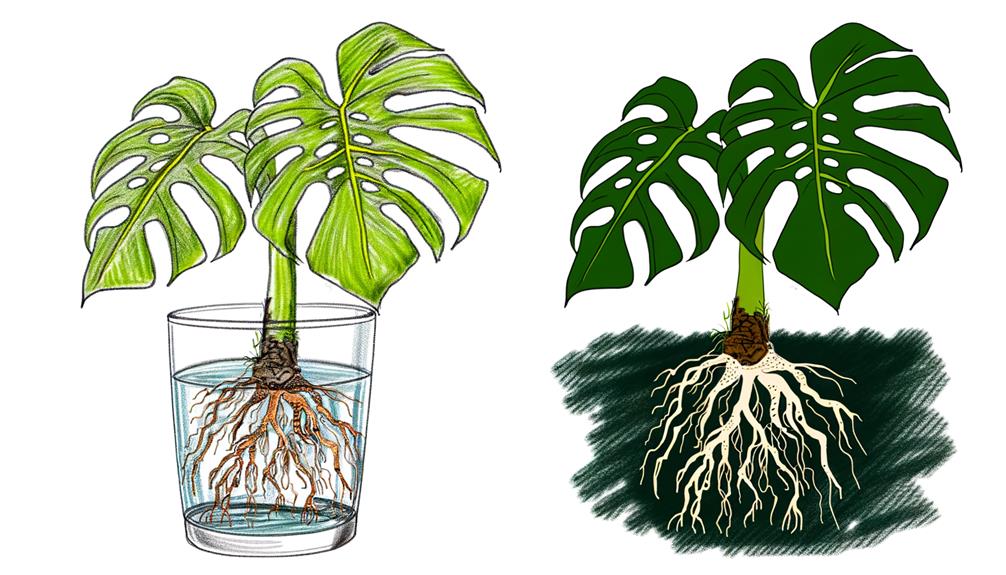
When you notice yellowing leaves, check for overwatering and guarantee the plant receives sufficient light.
To prevent root rot, use well-draining soil and avoid letting the cutting sit in waterlogged conditions.
Monitoring these factors closely helps maintain healthy growth during propagation.
Yellowing Leaves
Yellowing leaves on your Monstera Obliqua often indicate underlying issues that require immediate attention to prevent further damage. Assess your plant’s health by examining the following factors:
- Watering Practices: Overwatering can suffocate roots, while underwatering dehydrates them. Make sure the soil dries out slightly between waterings.
- Light Conditions: Insufficient light can cause yellowing. Place your plant in bright, indirect light to promote healthy growth.
- Nutrient Deficiency: A lack of essential nutrients, particularly nitrogen, can lead to yellow leaves. Use a balanced, water-soluble fertilizer during the growing season.
Root Rot Prevention
To prevent root rot in your Monstera Obliqua, make certain proper drainage by using a well-aerated potting mix and a container with adequate drainage holes. Avoid overwatering; allow the top inch of soil to dry out between waterings. Guarantee the environment is humid but not overly wet. Use a moisture meter to monitor soil moisture levels precisely.
| Preventive Measure | Description |
|---|---|
| Potting Mix | Use a mix with perlite or orchid bark |
| Drainage | Make sure pots have multiple drainage holes |
| Watering Schedule | Water only when the top inch is dry |
Regularly inspect roots for signs of rot. If detected, trim affected roots and repot the plant in fresh soil. Maintain airflow around the plant to reduce excess moisture.
Can Monstera Obliqua Grow In Water
Yes, Monstera Obliqua can grow in water, but it requires extra care and attention. Growing Monstera Obliqua in water is similar to propagating other Monstera species through water propagation. Here’s what you need to consider if you plan to grow it this way:
Steps for Growing Monstera Obliqua in Water:
- Cutting Preparation: Start with a healthy cutting that includes at least one node (the point where leaves and roots grow). The node is essential for rooting.
- Water Quality: Use filtered or distilled water to prevent chemicals like chlorine from harming the delicate plant. Avoid hard water or tap water with a high mineral content.
- Vessel: Use a transparent jar or glass to monitor root growth. Make sure the node is fully submerged in water, but the leaves should remain above the water to prevent rot.
- Humidity and Temperature: Since Monstera Obliqua thrives in high humidity and warm temperatures, make sure the plant is in a humid environment (preferably over 70%) and at a temperature between 20-27°C (68-80°F).
- Water Change: Regularly change the water every 3-5 days to prevent bacteria and algae buildup. Ensure the water stays clean and fresh to promote healthy root growth.
- Indirect Light: Place the cutting in bright, indirect light. Avoid direct sunlight, as it can scorch the delicate leaves or heat up the water too much.
- Root Development: Once roots start to develop (typically after a few weeks), you can continue growing the plant in water or transplant it to soil if you prefer. Monstera Obliqua is sensitive, so take care when transitioning from water to soil.
Challenges:
- Slow Growth: Monstera Obliqua naturally grows very slowly, and this will likely be the case in water as well. Be patient with the rooting and growth process.
- Fragility: The plant is quite fragile, and its roots are delicate. Keeping it in water too long without proper nutrients can lead to weak growth.
- Nutrient Deficiency: Since the plant won’t get nutrients from soil, it’s important to provide a diluted liquid fertilizer once in a while to give it the necessary nutrients for sustained growth.
Growing Monstera Obliqua in water is possible, but it requires careful maintenance and attention to ensure the plant remains healthy.
Conclusion
Think of propagating Monstera obliqua as baking a cake; each step is essential for success. With the right timing, careful selection, and proper care, your cuttings will thrive.
Remember, patience pays off; like a cake that needs time to rise, your Monstera cuttings need time to root.
By following this guide, you’ll transform your green thumb into a master baker of beautiful plants.
Happy propagating, and enjoy watching your indoor jungle grow!






